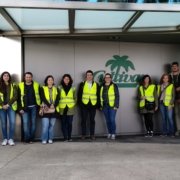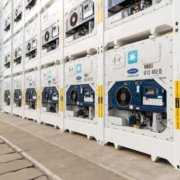Transporting perishables across the equator

Written by: Lidia Slawinska, Consultant
The end of the 20th and the beginning of the 21st century has brought tremendous progress to social, industrial and environmental aspects of society – all as part of the larger globalisation trend. In this issue of the #DidYouKnow series we look at how globalisation has affected the ability for us to receive perishable products from the other side of the globe and made it possible for us to diversity our diets with foods from other climates.
We are talking about, of course, the cold chain. New technologies in reefer transport and logistics have made it possible for the market of cold chain products to expand. The reefer is essentially a homogeneous transport product, but it works with markets that have a very broad range of products, ranging from pharmaceuticals to perishable foods (and even fresh flowers). How is it that we are able to find fresh avocados from Peru in our local (European)_supermarkets? How are delicacies from the Southeast Asian countries reaching our homes? The areas which produce the most perishable products—the southern states of the USA (California, Florida, Texas, Arizona), Hawaii, Puerto Rico, Mexico, the Caribbean, South America, and Southeast Asia—have in the past faced great marketing challenges due to their distance from the major markets of Eastern and Central United States, Canada, the Far East or Europe. It is through the wonders of intermodality and temperature-controlled transport – a supply chain that ends at the door of the final consumer – that we can enjoy the tropical delicacies in the old continent.
What are the factors that need to be taken into account when transporting perishable?
Fresh products continue to metabolize and eat up their nutrients throughout their shelf life. This process begins with the harvest or slaughter, and continues through packing, distribution, marketing and the final sale. The decomposition processes are all dependent upon temperature – the higher the temperature, the faster the degradation.
“In fact, as a general rule, most of these degradation processes double their rate for each increase of 10°C [1]” – a vital statistic for shippers and transport operators who need to preserve the integrity of their cargo during long-distance journeys.
This so-called Q10 quotient means that maintaining an edible product’s temperature at 10C less than the temperature during which it is handled can almost double the product’s shelf life. Though this is not a universal rule that can be applied to all products (some sub-tropical fruit can suffer damages due to extremely low temperatures), it is significant enough for professionals to consider, and thus offset their their losses.
When tropical delicacies are transported to opposite corners of the world, uniform quality in both product appearance and taste are essential. This is why packaging, refrigerating, pre-cooling, and storing are vital – the inability to do effectively will result in a waste of product, time and losses in profits.
Packaging
It is important to note, that alongside the refrigeration tactics used by transporters, packaging also takes centre stage – in particular in the cases of fruits and vegetables, plants, and cut flowers. Proper packaging ensures product protection during transport and facilitates transport. Improperly sized containers, for example, topped with rough handling by port infrastructures can lead to products damage. Overfilling can cause bruising and can also lead to decreased compression strength inside the container. Underfilling a container can also cause product damage by allowing for the product to move during uneasy transport conditions (rough seas, irregular road surfaces, etc).
Overall it is vital to ensure that the containers are properly packaged and prepared, with detailed considerations of the temperatures required for the preservation of the transported products. Knowing exactly what are the different stages and characteristics of this preparation will help you create a durable, efficient and sustainable cold chain.
Choosing the mode of transport
As previously hinted, the transport of temperature-sensitive goods is very particular, and therefore it is imperative to choose the correct mode of transport to ensure high quality services and product delivery. Intermodality plays a key role, as sometimes different modes would need to be used to maximise the efficiency of the cold chain. Once precooled, the items would need to be carefully loaded onto appropriate packaging and transported at stable temperatures. Therefore, the design and condition of the equipment used will need to be considered, alongside the mode of transport to be used (which depends on the distance to be crossed).
These decisions should be made in consideration with the following:
- Destination – where is the product heading
- Value of the product – are there certain losses that can be accepted by the client?
- Degree of product perishability – how temperature sensitive are the products?
- Amount of product to be transported
- Recommended storage temperature and relative humidity – important to take into account in particular with precooling and storage steps
- Outside temperature conditions at origin and destination points
- Time in transit to reach destination by air, land, or ocean transport – Refrigerated trailers and van containers are generally preferred for most high volume transports during a week or more
- Freight rates negotiated with the carriers – Services and schedules can change on a weekly basis. Are door-to-door services offered (generally the case with carriers who use containers and trailers, but air cargo has also been know to transport highly perishable goods). Air freight is considerably more costly and does not tend utilise refrigerated containers (although refrigerated air containers are used) – but the transit time is generally given in hours instead of days / weeks.
- Quality of transportation service – which can usually be gauged through past customer reviews, local trade publications, port authorities, among others.
On top of using the correct mode of transport, customers should also familiarise themselves with the refrigeration systems used to understand what kind would best protect their product. Some companies may opt for mechanical systems (which use diesel generated electric power), cryogenic (which use liquid or gaseous nitrogen), dry ice (low-cost but highly effective method to keep temperatures down), wet ice (which tend to be used as supplements to other cooling mechanisms and get placed on top of the containers to avoid product contamination), gel refrigerants (frozen containers of chemical eutectic gel to help maintain lower temperature within larger containers), ventilation (preferred for live-cargo and high – emission products as it employs a method of using air ventilation to circulate the buildup of CO2 or ethylene, etc). Though not extensive, this list demonstrates the large array of possible options that operators in the cold chain use.
From the above it is evident that the cold chain requires a myriad of additional considerations on top of the usual decisions that need to be taken when planning an efficient and sustainable transport chain. Through technological advancements we can now transport fresh vegetables from Almeria to the United Kingdom, and help transport fruit, tomatoes and other vegetables from the Northern shores of Africa and the Eastern Mediterraenean to the countries of the E.U, alongside tropical vegetables form the far East and West. All without worrying about significant product deterioration or losses.
These, and other topics, are covered in the Escola’s Technical Course on Temperature Controlled Transport. For more information about the upcoming edition, you can head to the course page, or contact us as info@escolaeuropea.eu.
Want to know more? Check out these additional resources:







